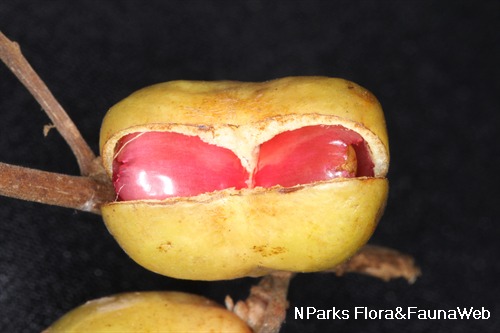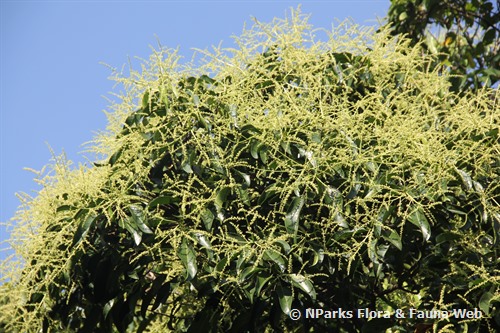_lowres.jpg)
Back
Bhesa paniculata Arn.
| Family Name: | Centroplacaceae |
| Common Name: | Biku-biku, Malayan Spindle Tree |
Bhesa paniculata, also known as Biku-biku, is a tree that have heart-shaped fruits. They gradually ripen from yellow to rose-red, and are fancied by birds and small mammals.
Name
Classifications and Characteristics
| Plant Division | Angiosperms (Flowering Seed Plants) (Dicotyledon) |
|---|---|
| Plant Growth Form | Tree (Big (>30m)) |
| Lifespan (in Singapore) | Perennial |
| Mode of Nutrition | Autotrophic |
| Plant Shape | Rounded, Broad / Mushroom / Hemispherical |
| Maximum Height | 35 m |
Biogeography
| Native Distribution | Southern India, south Myanmar, Sumatra, Peninsular Malaysia, Singapore, the Philippines, and Borneo |
|---|---|
| Native Habitat | Terrestrial (Primary Rainforest, Secondary Rainforest, Freshwater Swamp Forest) |
| Preferred Climate Zone | Tropical |
| Local Conservation Status | Native to Singapore (Least Concern (LC)) |
Description and Ethnobotany
| Growth Form | It is a medium-sized tree up to 35 m tall, with a dark green, heavy crown. |
|---|---|
| Foliage | Its spirally arranged leaves have long stalks that are swollen at both ends. They also have thinly leathery leaf blades that are oval to oblong, pointing downwards, and 5.5–39 by 2–15 cm, with finely crowded, parallel veinlets between the secondary veins. |
| Flowers | Its flowers are faintly fragrant, yellowish-cream or dark purplish-red, and 5 mm wide. They are also arranged in panicles up to 38 cm long at the end of leafy twigs. |
| Fruit | Its 2-lobed fruits are flattened heart-shaped, 1–2 by 0.8–1.3 cm, yellow then rose-red, and found in large clusters. They split into two parts when ripe to reveal 2–4 seeds half covered with crimson pink pulp. Its seeds are rounded, pale brown, and 6–8 mm wide. |
| Habitat | It grows in lowland primary and secondary forests, and peat swamp forest, to submontane forests up to 1,500 m altitude. It is occurs locally in Nee Soon Swamp Forest, in the vicinity of Upper Seletar Reservoir, and Old Upper Thomson Road. |
| Associated Fauna | Its flowers are insect-pollinated and the fruits are eaten by birds and small mammals. |
| Etymology | Pali bhesa and bhesa bol, referring to the resin of false myrrh; Latin paniculatus, having flowers arranged in a loose, branched cluster (a panicle) |
| Ethnobotanical Uses | Edible Plant Parts : Edible Fruits Food (Fruit or Vegetable): The fruits are edible. Timber & Products: The wood is used for constructing houses, and making beams, floorboards, and poles. Others: It is occasionally cultivated as an ornamental tree. |
Landscaping Features
| Landscaping | This species resembles oak- and chestnut-trees owing to its attractive cluster of yellowish-cream or dark purplish-red flowers. It also resembles the European spindle tree (Euonymus europaeus) owing to its attractive rose-red fruits. It may be suitable for parks and large gardens. It needs greater care after transplanting, as the transplanted trees or saplings tend to die easily from water stress so must be watered regularly during the establishment period. |
|---|---|
| Desirable Plant Features | Ornamental Flowers, Ornamental Fruits |
| Landscape Uses | General, Parks & Gardens |
Fauna, Pollination and Dispersal
| Fauna Pollination Dispersal Associated Fauna | Bird-Attracting |
|---|---|
| Pollination Method(s) | Biotic (Fauna) |
| Seed or Spore Dispersal | Biotic (Fauna) |
Plant Care and Propagation
| Light Preference | Full Sun, Semi-Shade |
|---|---|
| Water Preference | Moderate Water |
| Plant Growth Rate | Fast to Moderate |
| Rootzone Tolerance | Moist Soils, Well-Drained Soils |
| Propagation Method | Seed |
Floral (Angiosperm)
| Flower Colour(s) | Cream / Off-White, Purple, Red |
|---|---|
| Flower Grouping | Cluster / Inflorescence |
| Flower Location | Terminal |
| Inflorescence Type | Panicle |
| Inflorescence Size | 38 m |
Fruit, Seed and Spore
| Mature Fruit Colour(s) | Red, Yellow / Golden |
|---|---|
| Mature Seed Colour(s) | Brown |
| Seed Description | Its seeds are rounded, pale brown, and 6–8 mm wide. |
| Seed Quantity Per Fruit | Few (1-5) |
Image Repository
Others
| Master ID | 2014 |
|---|---|
| Species ID | 3306 |
| Flora Disclaimer | The information in this website has been compiled from reliable sources, such as reference works on medicinal plants. It is not a substitute for medical advice or treatment and NParks does not purport to provide any medical advice. Readers should always consult his/her physician before using or consuming a plant for medicinal purposes. |


_lowres.jpg)







_lowres.jpg)
_lowres.jpg)
_lowres.jpg)
